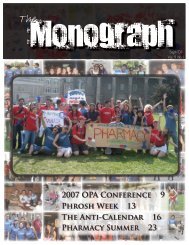March/April - University of Toronto's Undergraduate Pharmacy Society
March/April - University of Toronto's Undergraduate Pharmacy Society
March/April - University of Toronto's Undergraduate Pharmacy Society
Create successful ePaper yourself
Turn your PDF publications into a flip-book with our unique Google optimized e-Paper software.
Meditation and<br />
Medication: Yoga’s<br />
Role in Healthcare<br />
By: Zenah Surani, 1T2<br />
Over this past school year, I acquired<br />
a new addiction. It gives me lots <strong>of</strong> energy,<br />
relieves stress, and it makes me break out<br />
into a shirt-drenching sweat. Best <strong>of</strong> all,<br />
it’s not a harmful one. In fact, it may just<br />
be one <strong>of</strong> the most powerful systems <strong>of</strong><br />
health and well-being out there. I’m talking<br />
about yoga. Western medicine is generally<br />
governed by the appearance <strong>of</strong> symptoms.<br />
However, yoga deals with health in a far<br />
more holistic way. It envisions health as<br />
a state <strong>of</strong> being—only when your bodily<br />
systems are being used to their optimal<br />
function are they aligned, and in turn, you<br />
are then at your highest state <strong>of</strong> health.<br />
It truly connects the mind, body, and<br />
soul—in stretching your muscles, you are<br />
directly feeding into your nervous system<br />
and creating peace <strong>of</strong> mind. Certain poses<br />
performed and pranayama (breathing)<br />
with practice can positively impact the<br />
cardiovascular system, boost the immune<br />
system, and improve digestion. This<br />
connectivity can be translated to the<br />
body—it is possible to improve one body<br />
system by trying to improve all <strong>of</strong> them.<br />
Yoga is definitely not just for people<br />
who are super flexible and athletic.<br />
Although there are occasionally some<br />
superstars at the yoga studio I go to, the<br />
vast majority <strong>of</strong> us are just normal people.<br />
I have a hard time with the floor poses (yintype<br />
poses). Some have trouble touching<br />
their toes in a forward bend or with<br />
balancing poses. However, the<br />
challenge appeals to me, and seeing<br />
my progress over the past year has<br />
been satisfying, to say the least.<br />
The difference between a flexible<br />
person and a less flexible person<br />
is that the former has to work<br />
harder to feel the same stretch.<br />
A big part <strong>of</strong> the yoga<br />
experience is the breathing<br />
(pranayama). Ashtanga yoga, a vigorous<br />
form <strong>of</strong> yoga originating in Mysore, India,<br />
encourages the practice <strong>of</strong> the ujjayi breath.<br />
This is closed-mouth breathing, imitating<br />
the deep, throaty breath <strong>of</strong> Darth Vader.<br />
One should be able to feel the breath as<br />
it passes the back <strong>of</strong> the throat, and with<br />
practice, this type <strong>of</strong> breathing should be<br />
silent. When we are stressed, we tend to<br />
breathe quickly. Shallow, rapid breaths<br />
deliver less air to the alveoli, leading to<br />
decreased oxygen saturation <strong>of</strong> the blood.<br />
Yogis take fewer breaths <strong>of</strong> greater volume,<br />
calming their nervous systems, increasing<br />
their exercise capacity and blood oxygen<br />
saturation.<br />
A study performed at a university<br />
in Benares, India, found that yoga<br />
was beneficial for the depressed. A<br />
yoga group and a comparison group<br />
given antidepressants showed similar<br />
improvements in neurotransmitter levels<br />
- a great rise in serotonin levels and a<br />
decrease in monoamine oxidase and<br />
cortisol (the ‘stress hormone’) levels.<br />
Stress can lead to intestinal problems<br />
like diarrhea, constipation or even IBS.<br />
Yoga postures such as twists wring out<br />
venous blood from internal organs, such as<br />
the large intestine, improving oxygenated<br />
blood flow to those organs once the twist<br />
is relieved. This can help to alleviate<br />
these problems by helping food and waste<br />
products make their way down the large<br />
intestine normally. Practices learned in<br />
yoga can also be taken outside the studio<br />
to everyday life. For instance, when we are<br />
doing a particularly tough posture at the<br />
studio, the teacher <strong>of</strong>ten tells the class to<br />
unclench our jaws, un-squint<br />
our eyes, and to scan<br />
our bodies for any<br />
tension and to<br />
‘ b r e a t h<br />
i n t o<br />
that tension’ to relieve it. Similarly, stress<br />
we experience in everyday life can cause<br />
us to tighten up the muscles in our face<br />
and clench our jaws. Before I started<br />
practicing yoga, I didn’t even realize I<br />
did this! This can lead to a worsening <strong>of</strong><br />
stress level and mood, and may even lead<br />
to chronic muscle fatigue and soreness.<br />
Learning these stress-relieving techniques<br />
from regular yoga practice, I’ve realized<br />
that things that used to stress me out no<br />
longer do.<br />
Finally, as students, we <strong>of</strong>ten have<br />
many things on our minds, whether it’s<br />
school, weekend plans, personal issues, or<br />
even class gossip. Yoga helps with spiritual<br />
growth. Dukha, or suffering, is different<br />
from physical pain. Pain sometimes cannot<br />
be avoided, but suffering (in yogic terms)<br />
depends on your state <strong>of</strong> mind. Thoughts<br />
and emotions from the past, for instance,<br />
can hinder healing and foster discontent.<br />
While practicing yoga, you have no choice<br />
but to focus on the postures you are doing<br />
since most <strong>of</strong> the time, they are quite<br />
challenging. In doing this, your mind must<br />
concentrate, almost forgetting about what<br />
has happened that day. At the end <strong>of</strong> the<br />
class your stress and issues are still there,<br />
but you are now ready to take them on<br />
with a renewed sense <strong>of</strong> self and peace <strong>of</strong><br />
mind.<br />
Healthcare pr<strong>of</strong>essionals <strong>of</strong>ten<br />
recommend yoga practice as a nonpharmalogical<br />
therapy to their patients<br />
with ailments such as arthritis, HIV/AIDS,<br />
cancer, back pain, and a host <strong>of</strong> others<br />
because <strong>of</strong> its proven physical and mental<br />
benefits. Although January 1 st seems like a<br />
long way away, it’s not too late to make a<br />
resolution! Grab a mat and take up yoga!<br />
Whether its Ashtanga, Hatha, Vinyasa or<br />
Yin—you are sure to find a style that you<br />
enjoy and that will make you feel great. It<br />
may even become your new addiction! M<br />
Reference:<br />
McCall, Timothy, M.D. “Yoga as<br />
Medicine: The Yogic Prescription<br />
for Health and Healing.”<br />
B a n t a m<br />
B o o k s<br />
N e w<br />
Yo r k ,<br />
2007.<br />
The Monograph - <strong>March</strong> 2010 11
















